Abstract
Intubation techniques and scintigraphic studies were used to determine the origin and mechanism of diarrhoea in a patient with medullary thyroid carcinoma, high plasma immunoreactive calcitonin and normal circulating serotonin, substance P and prostaglandins E2 and F2 alpha. Normal function of the small intestine was found for the following: (a) absorption tests; (b) water and electrolyte absorption in the proximal jejunum; (c) 24 hour flow rate and composition of fluid entering the colon and (d) gastric emptying rate and small intestinal progression of a normal meal. By contrast, colonic function was markedly impaired in three ways: (a) water absorption was decreased by half; (b) as the main excreted solutes were organic acids, a large electrolyte gap was recorded in faecal water, and (c) colonic transit time of the meal marker was very short, and was in agreement with the rapid transit of ingested radioopaque markers. These data strongly suggest that decreased absorption in the colon secondary to a motor disturbance is the main mechanism of diarrhoea in this case of medullary thyroid carcinoma, while calcitonin induced small intestinal fluid secretion suggested earlier is either non-existent, or only of minor importance.
Full text
PDF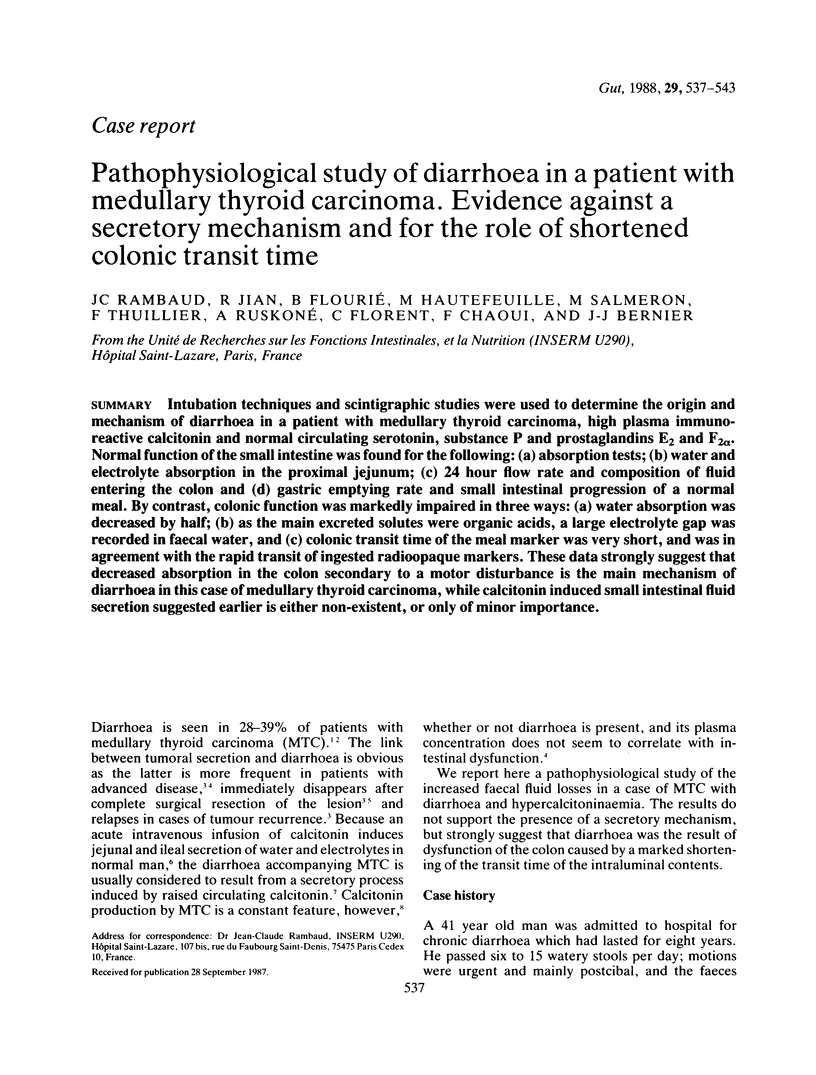
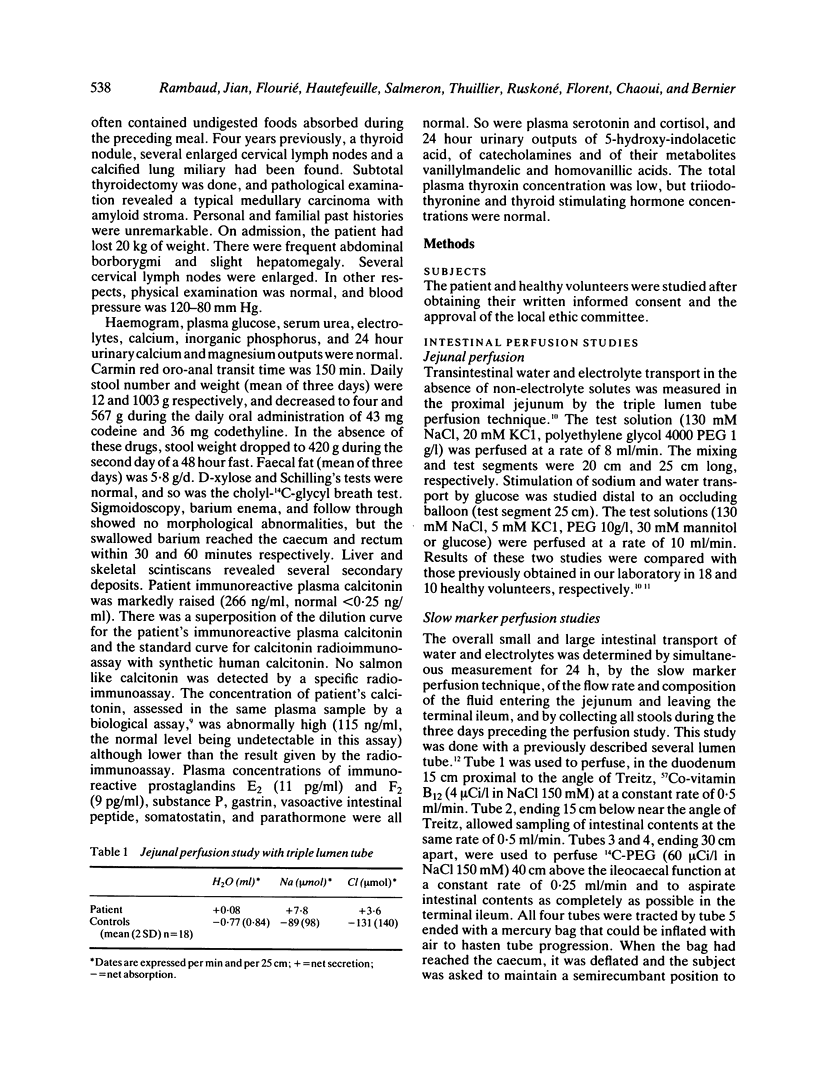
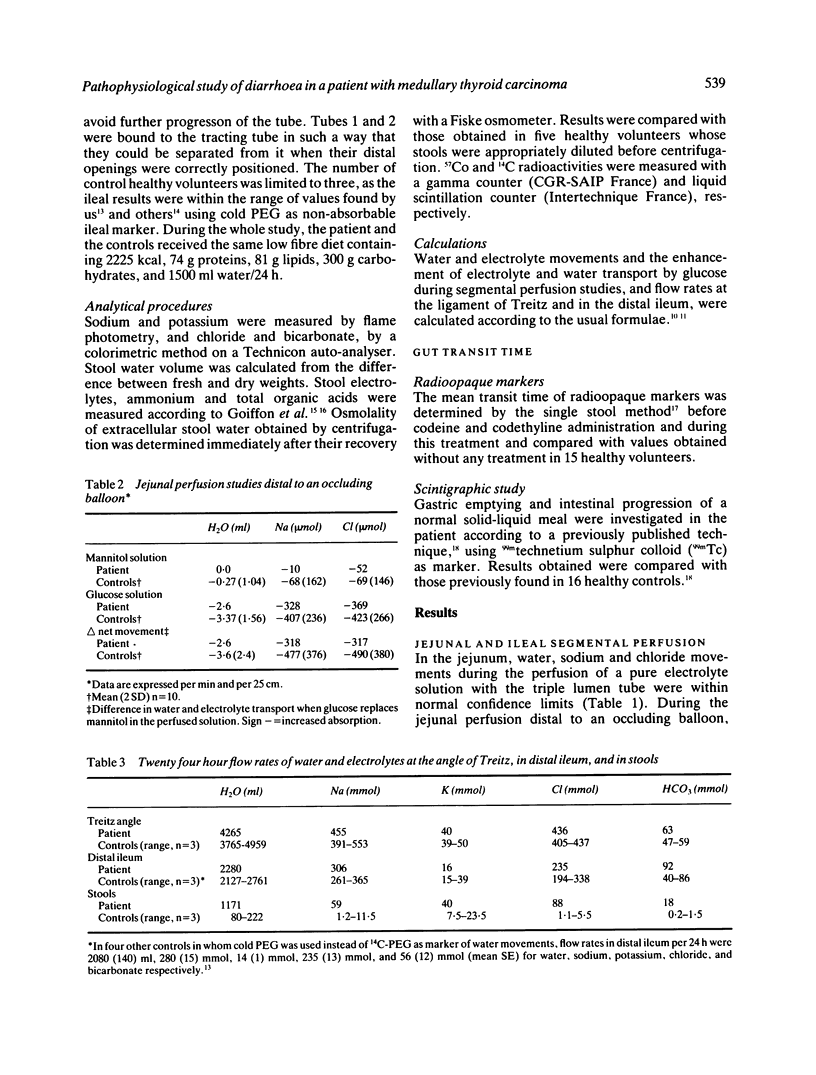
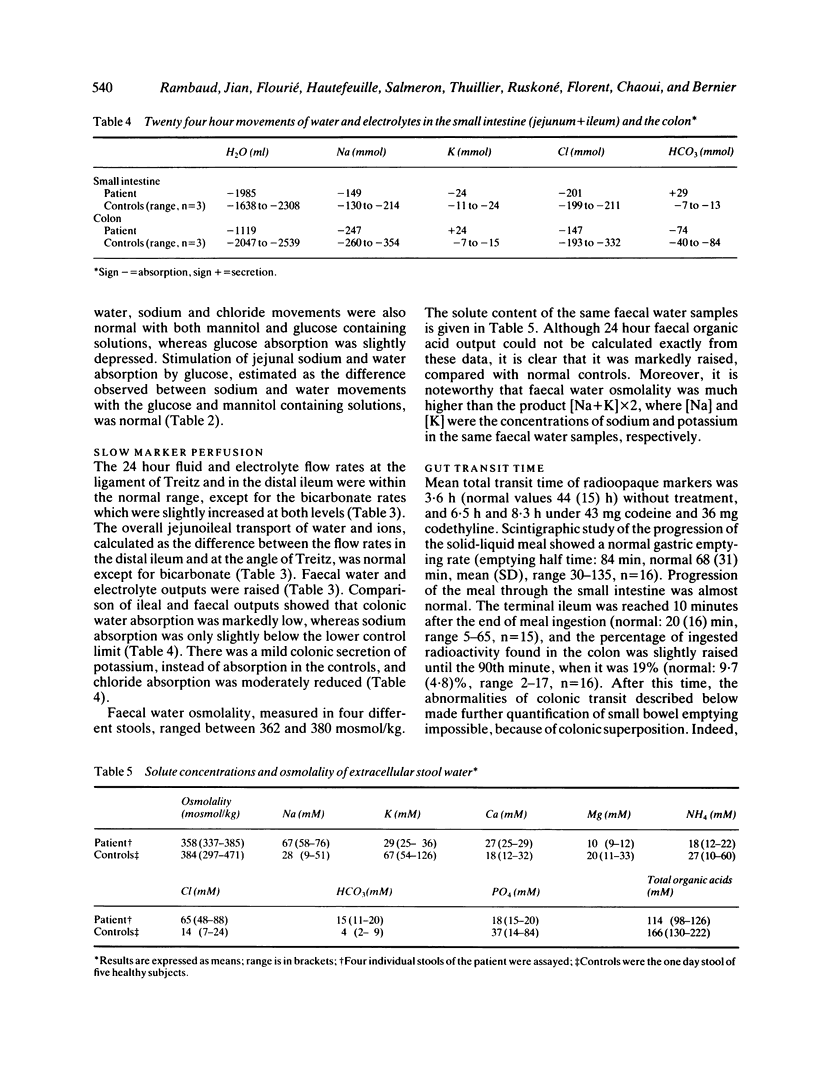
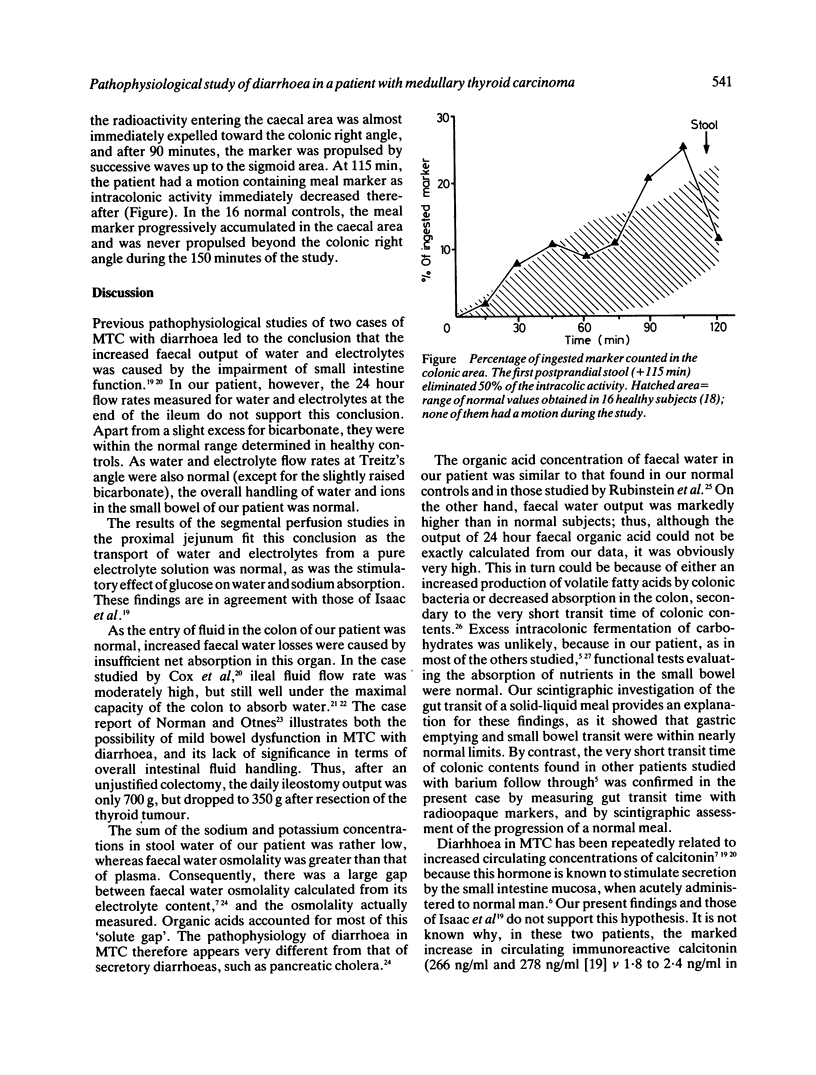
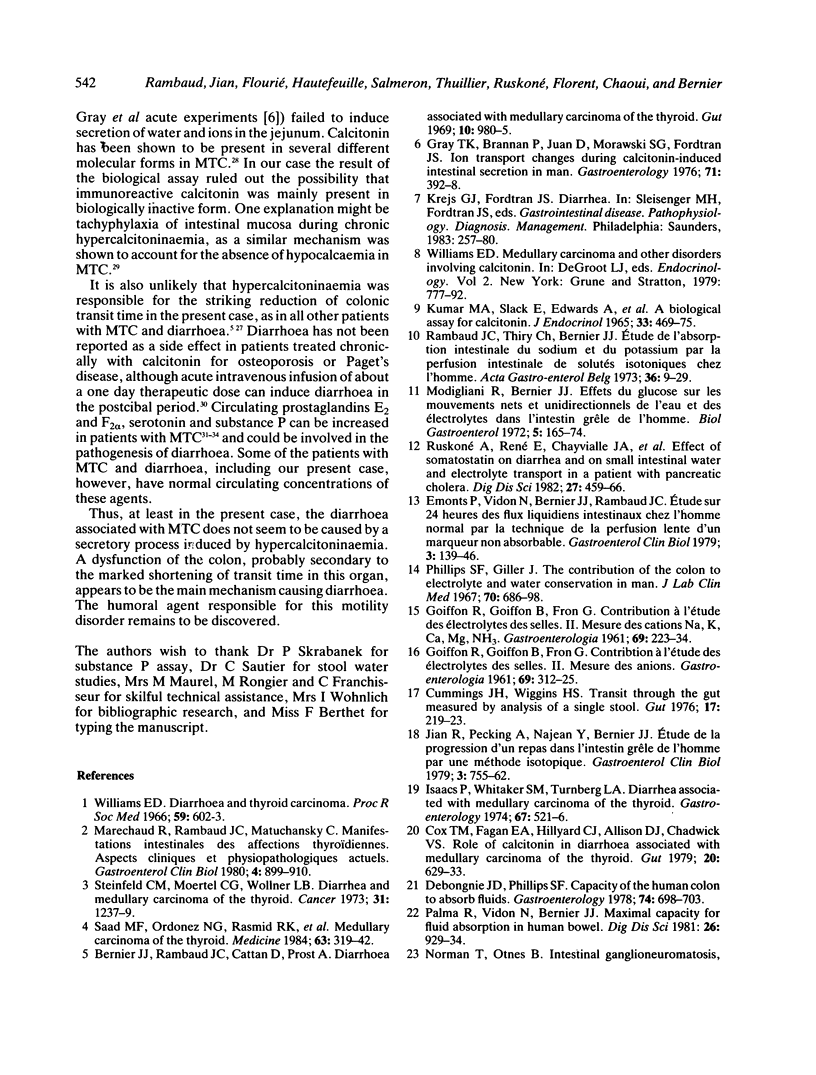
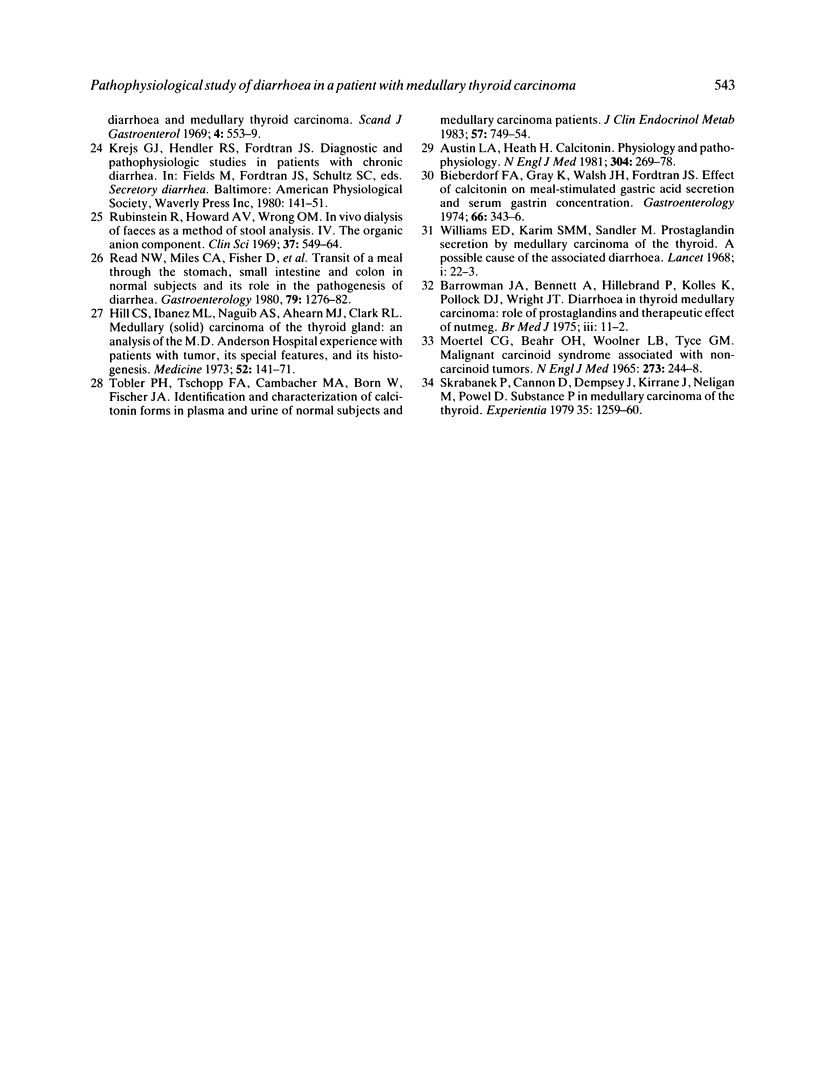
Selected References
These references are in PubMed. This may not be the complete list of references from this article.
- Austin L. A., Heath H., 3rd Calcitonin: physiology and pathophysiology. N Engl J Med. 1981 Jan 29;304(5):269–278. doi: 10.1056/NEJM198101293040505. [DOI] [PubMed] [Google Scholar]
- Barrowman J. A., Bennett A., Hillenbrand P., Rolles K., Pollock D. J., Wright J. T. Diarrhoeae in thyroid medullary carcinoma: role of prostaglandins and therapeutic effect of nutmeg. Br Med J. 1975 Jul 5;3(5974):11–12. doi: 10.1136/bmj.3.5974.11. [DOI] [PMC free article] [PubMed] [Google Scholar]
- Bernier J. J., Rambaud J. C., Cattan D., Prost A. Diarrhoea associated with medullary carcinoma of the thyroid. Gut. 1969 Dec;10(12):980–985. doi: 10.1136/gut.10.12.980. [DOI] [PMC free article] [PubMed] [Google Scholar]
- Bieberdorf F. A., Gray T. K., Walsh J. H., Fordtran J. S. Effect of calcitonin on meal-stimulated gastric acid secretion and serum gastrin concentration. Gastroenterology. 1974 Mar;66(3):343–346. [PubMed] [Google Scholar]
- Cox T. M., Fagan E. A., Hillyard C. J., Allison D. J., Chadwick V. S. Rôle of calcitonin in diarrhoea associated with medullary carcinoma of the thyroid. Gut. 1979 Jul;20(7):629–633. doi: 10.1136/gut.20.7.629. [DOI] [PMC free article] [PubMed] [Google Scholar]
- Cummings J. H., Wiggins H. S. Transit through the gut measured by analysis of a single stool. Gut. 1976 Mar;17(3):219–223. doi: 10.1136/gut.17.3.219. [DOI] [PMC free article] [PubMed] [Google Scholar]
- Debongnie J. C., Phillips S. F. Capacity of the human colon to absorb fluid. Gastroenterology. 1978 Apr;74(4):698–703. [PubMed] [Google Scholar]
- Emonts P., Vidon N., Bernier J. J., Rambaud J. C. Etude sur 24 heures des flux liquidiens intestinaux chez l'homme normal par la technique de la perfusion lente d'un marqueur non asorbable. Gastroenterol Clin Biol. 1979 Feb;3(2):139–146. [PubMed] [Google Scholar]
- Gray T. K., Brannan P., Juan D., Morawski G., Fordtran J. S. Ion transport changes during calcitonin-induced intestinal secretion in man. Gastroenterology. 1976 Sep;71(3):392–398. [PubMed] [Google Scholar]
- Isaacs P., Whittaker S. M., Turnberg L. A. Diarrhea associated with medullary carcinoma of the thyroid. Studies of intestinal function in a patient. Gastroenterology. 1974 Sep;67(3):521–526. [PubMed] [Google Scholar]
- Jian R., Pecking A., Najean Y., Bernier J. J. Etude de la progression d'un repas dans l'intestin grêle de l'homme par une méthode scintigraphique. Gastroenterol Clin Biol. 1979 Oct;3(10):755–762. [PubMed] [Google Scholar]
- Kumar M. A., Slack E., Edwards A., Soliman H. A., Baghdiantz A., Foster G. V., MacIntyre I. A biological assay for calcitonin. J Endocrinol. 1965 Nov;33(3):469–475. doi: 10.1677/joe.0.0330469. [DOI] [PubMed] [Google Scholar]
- Maréchaud R., Rambaud J. C., Matuchansky C. Manifestations intestinales des affections thyroïdiennes. Aspects cliniques et physiopathologiques actuels. Gastroenterol Clin Biol. 1980 Dec;4(12):899–910. [PubMed] [Google Scholar]
- Modigliani R., Bernier J. J. Effets du glucose sur les mouvements nets et unidirectionnels de l'eau et des électrolytes dans l'intestin grêle de l'homme. Biol Gastroenterol (Paris) 1972;5(3):165–174. [PubMed] [Google Scholar]
- Normann T., Otnes B. Intestinal ganglioneuromatosis, diarrhoea and medullary thyroid carcinoma. Scand J Gastroenterol. 1969;4(7):553–559. [PubMed] [Google Scholar]
- Palma R., Vidon N., Bernier J. J. Maximal capacity for fluid absorption in human bowel. Dig Dis Sci. 1981 Oct;26(10):929–934. doi: 10.1007/BF01309499. [DOI] [PubMed] [Google Scholar]
- Phillips S. F., Summerskill W. H. Water and electrolyte transport during maintenance of isotonicity in human jejunum and ileum. J Lab Clin Med. 1967 Oct;70(4):686–698. [PubMed] [Google Scholar]
- Rambaud J. C., Thiry C., Bernier J. J. Etude de l'absorption intestinale du sodium et du potassium, par la perfusion intestinale de solutés isotoniques chez l'homme. Acta Gastroenterol Belg. 1973 Jan-Feb;36(1):9–29. [PubMed] [Google Scholar]
- Read N. W., Miles C. A., Fisher D., Holgate A. M., Kime N. D., Mitchell M. A., Reeve A. M., Roche T. B., Walker M. Transit of a meal through the stomach, small intestine, and colon in normal subjects and its role in the pathogenesis of diarrhea. Gastroenterology. 1980 Dec;79(6):1276–1282. [PubMed] [Google Scholar]
- Rubinstein R., Howard A. V., Wrong O. M. In vivo dialysis of faeces as a method of stool analysis. IV. The organic anion component. Clin Sci. 1969 Oct;37(2):549–564. [PubMed] [Google Scholar]
- Ruskoné A., René E., Chayvialle J. A., Bonin N., Pignal F., Kremer M., Bonfils S., Rambaud J. C. Effect of somatostatin on diarrhea and on small intestinal water and electrolyte transport in a patient with pancreatic cholera. Dig Dis Sci. 1982 May;27(5):459–466. doi: 10.1007/BF01295657. [DOI] [PubMed] [Google Scholar]
- Saad M. F., Ordonez N. G., Rashid R. K., Guido J. J., Hill C. S., Jr, Hickey R. C., Samaan N. A. Medullary carcinoma of the thyroid. A study of the clinical features and prognostic factors in 161 patients. Medicine (Baltimore) 1984 Nov;63(6):319–342. [PubMed] [Google Scholar]
- Skrabanek P., Cannon D., Dempsey J., Kirrane J., Neligan M., Powell D. Substance P in medullary carcinoma of the thyroid. Experientia. 1979 Sep 15;35(9):1259–1260. doi: 10.1007/BF01963325. [DOI] [PubMed] [Google Scholar]
- Steinfeld C. M., Moertel C. G., Woolner L. B. Diarrhea and medullary carcinoma of the thyroid. Cancer. 1973 May;31(5):1237–1239. doi: 10.1002/1097-0142(197305)31:5<1237::aid-cncr2820310530>3.0.co;2-k. [DOI] [PubMed] [Google Scholar]
- Tobler P. H., Tschopp F. A., Dambacher M. A., Born W., Fischer J. A. Identification and characterization of calcitonin forms in plasma and urine of normal subjects and medullary carcinoma patients. J Clin Endocrinol Metab. 1983 Oct;57(4):749–754. doi: 10.1210/jcem-57-4-749. [DOI] [PubMed] [Google Scholar]
- Williams E. D. Diarrhoea and thyroid carcinoma. Proc R Soc Med. 1966 Jul;59(7):602–603. [PMC free article] [PubMed] [Google Scholar]
- Williams E. D., Karim S. M., Sandler M. Prostaglandin secretion by medullary carcinoma of the thyroid. A possible cause of the associated idarrhoea. Lancet. 1968 Jan 6;1(7532):22–23. doi: 10.1016/s0140-6736(68)90010-x. [DOI] [PubMed] [Google Scholar]


